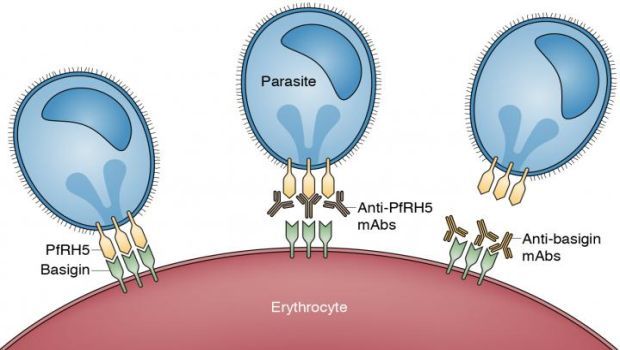Stopping Malaria in Its Tracks


Malaria parasites depend on the interaction between basigin and PfRH5 to invade (left). Antibodies against PfRH5 can block invasion (middle), but this strategy is vulnerable to resistance development. A new strategy, described by Zenonos et al., uses antibodies against basigin to block invasion (right). image courtesy of Rockefeller University Press
A new drug acts as a roadblock for malaria, curing mice of established infection, according to a study in the Journal of Experimental Medicine. Treatment was not associated with obvious side effects, suggesting that the drug may also be safe and effective in humans.
Nearly 200 million cases of malaria occur worldwide each year, and roughly 500,000 people (mostly African children) die of the disease. Malaria is caused by infection with the parasite Plasmodium falciparum (Pf), and although the disease can be treated with anti-malarial drugs, the drugs are harsh and resistance often develops.
In 2011, a group of scientists at the Wellcome Trust Sanger Institute in the UK discovered that a human protein called basigin was required for all strains of Pf to invade red blood cells, an essential stage of the parasite's life cycle. Antibodies that block the interaction between basigin and the parasite protein PfRH5 were known to block Pf infection in culture, and the Sanger Institute group has now developed a nontoxic anti-basigin drug (called Ab-1) that cured mice of established blood infection.
The transition of promising new drugs from mice to humans usually requires costly and time-consuming clinical trials, but the path for Ab-1 may be less arduous. Basigin has also been implicated in the progression of certain cancers and in graft-versus-host disease in transplant patients, and drugs that block the protein have already proven safe and effective in patients and are already in clinical use.
Reference: Zenonos, Z.A., et al. 2015. J. Exp. Med. doi:10.1084/jem.20150032
Source: Journal of Experimental Medicine, Rockefeller University Press
IDEA in Action: A Strategic Approach to Contamination Control
January 14th 2025Adopting IDEA—identify, define, explain, apply—streamlines contamination control. Infection control professionals can mitigate risks through prevention, intervention, and training, ensuring safer health care environments and reducing frequent contamination challenges.
Balancing Freedom and Safety: When Public Health Mandates Are Necessary
January 9th 2025Public health mandates, such as lockdowns, masking, and vaccination, balance liberty and safety, ensuring critical protections during pandemics like COVID-19 while fostering long-term survival through science.
Long-Term Chronicles: Infection Surveillance Guidance in Long-Term Care Facilities
January 8th 2025Antibiotic stewardship in long-term care facilities relies on McGeer and Loeb criteria to guide infection surveillance and appropriate prescribing, ensuring better outcomes for residents and reducing resistance.
Considering Avian Flu: World Health Organization Expert Warns Against Raw Milk
January 6th 2025Drinking raw milk poses risks of disease transmission, especially with H5N1 outbreaks. Expert Richard J. Webby, PhD, advises against raw cow or goat milk consumption due to its unpredictable and significant risks.